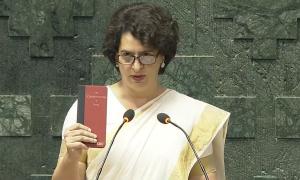Stringing together these headlines from rediff.com's coverage of PanIIT 2006 is in sharp contrast to Deng Xiao Ping's dictum for China: 'Tao guang yang hui, which literally translates to 'Hide brightness, nourish obscurity.' While IITians and Indians are busy doing victory laps, China and Chinese educational institutions have been going by the mantra of 'bide our time and focus on building ourselves'
I speak as a proud IIT Bombay alumnus who has spent over ten years working with fellow alumni in building the IIT Bombay Heritage Fund (IITBHF), one of India's leading alumni organizations, which has helped raise over $20 million for IIT Bombay's Tryst with Excellence.
IITBHF helped facilitate donations from prominent alumni to fund eponymous schools such as the Kanwal Rekhi School of IT (KReSIT) and the Shailesh J Mehta School of Management (SJSoM). IITBHF and IITBAA are now getting geared up for our Golden Jubilee celebrations beginning next year, along with an ambitious fundraising drive to support IIT Bombay's mission 'to create an ambience in which new ideas, research and scholarship flourish and from which the leaders and innovators of tomorrow emerge.'
The IITs have become a truly global brand over the years. It all began with the BusinessWeek cover story about India's Whiz Kids in 1998. And it probably culminated with the CBS 60 Minutes segment on the IITs in 2002, which was arguably the seminal tipping point in changing the perception about IITians and Indians in general in the West. Having had the privilege of working with both the author of the BusinessWeek article as well as Leslie Stahl's CBS 60 Minutes crew, I certainly count myself as a charter member of the cheerleading crew for the IITs.
India's economic boom was built in many ways on the reputation of IITians and NRIs who left the country and achieved great success in developed economies. The Indian Diaspora showed the world what Indians -- not just IITians -- are capable of. The 'brain drain' of the 1970s and 1980s has now become the 'brain circulation' of the 1990s and 2000s. The sapling planted by Pandit Nehru has become a mighty tree, and spread its branches into the world. The IIT brand exists.
However, before we get too giddy from the backslapping, we need to remind ourselves that the reality has to match up to the brand image. Instead of endlessly hyping the image itself, we need to focus on building the edifice. It is somewhat presumptuous -- and arguably preposterous -- to speak of the IITs in the same breath as the top universities of the world, notwithstanding the Times Higher Education Supplement rankings.
The state of the IITs and higher education in India in general is dismal. One has to remember that by selecting youngsters from the top 3,000 to 4,000 rank holders in a nation of a billion, it is inevitable that IITians will do well, regardless of whether the IITs add any value or not. But has the quality of research, the quantity of publications, and the depth of the faculty reached anywhere close to the calibre of the MITs and Stanfords of the world? Without taking anything away from the many wonderful and dedicated professors and faculty members at the IITs, I am afraid the answer is that the IITs are not even close.
According to a somewhat dated McKinsey study from the 1990s, the typical IIT was granted 3 to 6 patents against 64 for Stanford engineering and 102 for MIT. The number of citations per faculty between was 2 to 3 for the typical IIT versus 52 in the case of Stanford and 45 for MIT.
I would be happy to be proven wrong, but I doubt if the relative statistics have improved in any significant way since then. Even worse, I wonder if India's department of education is interested or able to dedicate the level of resources needed to compete with the Chinese in this realm, let alone the US.
It is a game of numbers, both of rupees/dollars and body counts. The IITs do not produce anywhere close to the number of MTechs and PhDs needed to create a pipeline of future faculty members and researchers. We at IITBHF are working with our alma mater in trying to recruit faculty for IIT Bombay via an effort called the Faculty Academic Network (FAN). However, lack of adequate research facilities and support makes it well nigh impossible to convince top PhDs to take up faculty jobs, or to stay there after they join.
The Rao Committee, which studied higher education in India, pointed out that India needs well over 10,000 PhDs and twice as many MTech. degree holders. Meanwhile, India produces barely 400 engineering PhDs a year, mostly from the IITs and the Indian Institute of Science.
Even worse, India is falling behind China. A constant theme I hear from Indian-American faculty members at top schools in the US is that the Chinese government has become extremely aggressive in funding Chinese universities to enable them to recruit the best and brightest expatriate faculty members and researchers to come back to the homeland.
In addition, China is much more adept at snagging leading conferences and its researchers embrace international journals and organisations. Indian researchers and faculty members are more likely to be satisfied with domestic journals and organizations, often driven by an exaggerated sense of pride in shunning the phoren journals and the not-invented-here syndrome.
As it is, the IITs are barely producing 5,000 to 6,000 graduates for a country of 1 billion. To give some perspective, just one of the Ivy League universities -- Cornell -- where my son started as a Freshman this Fall, admitted 3,238 students for the Class of 2010. And the US has at least 20 to 30 such universities of Ivy League calibre in a nation that is one-third the size of India.
Indians and IITians should shun hubris which contrasts with the sharp focus of China, South Korea and other nations, who are spending less time on self-congratulation and focusing on building truly world-class universities.
While it is wonderful to have events like the upcoming PanIIT 2006 in Mumbai, the focus at these events should be less on rah-rah backslapping and more on identifying the shortcomings of the IITs and the Indian educational system. IITians should be pressuring the Indian government, industry and alumni to provide the funding and resources needed to make the IITs into genuine peers of the MITs and Stanfords of the world.
Even more importantly, India needs to support and fund excellence in many more Indian universities, and not all of them need to be renamed as IITs. CalTech and Stanford did not become well-known by calling themselves the MITs of the West Coast.
Rather than hype the IIT brand ad nauseam, India should build BITS, the NITs, Pune University's CoE, Delhi Engineering College and dozens of other Indian universities into centers of excellence in research and teaching.
With some luck, there will come a day when the IITs will become truly world-class. And they will no longer be the only globally branded university from India. Until then, Deng Xiao Ping's advice to Tao guang yang hui is worth remembering.
Ram Kelkar is a Chicago-based investment professional and a Director of the IIT Bombay Heritage Fund. He is an alumnus of IIT Bombay and the Wharton School.








More from rediff